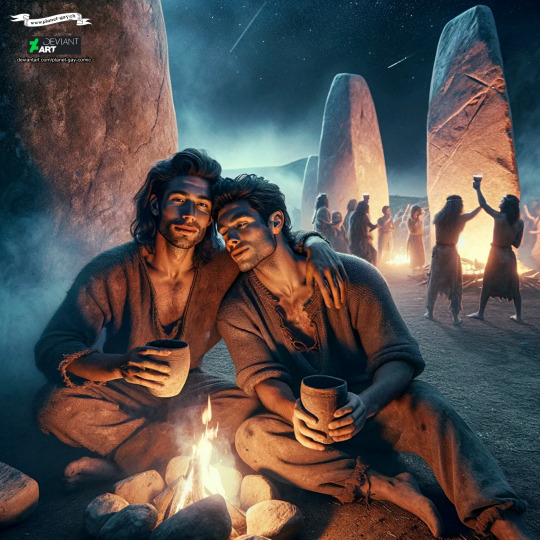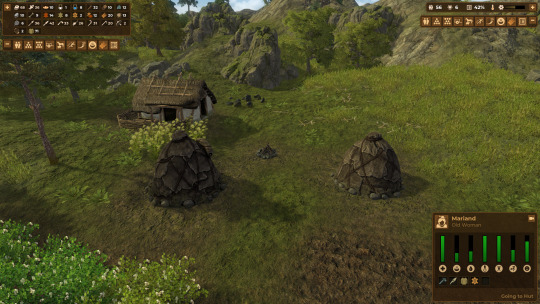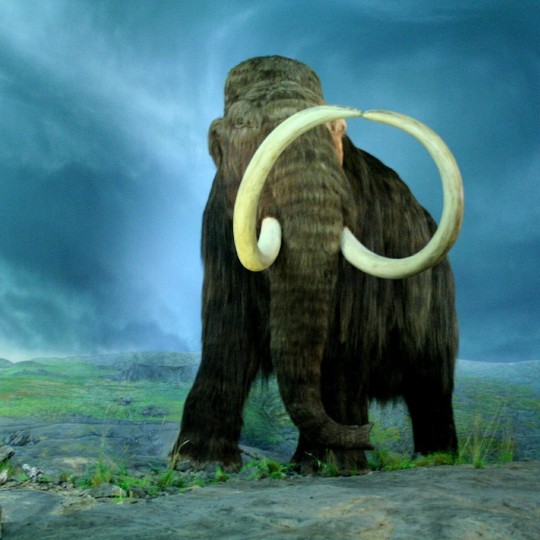#StoneAge
Explore tagged Tumblr posts
Photo

Homo rudolfensis is an early human species that lived in East Africa between c. 2.5 and 1.8 million years ago. It is known from a handful of skull, jaw and teeth fragments that remind alternatingly of Homo or of Australopithecus and that piece together to reveal a relatively large-brained, flat-faced species with robust teeth capable of chewing through tough plants. The associated dates mean that Homo rudolfensis was around at a time that saw the emergence of our genus of Homo – a time still very much shrouded in mystery as the fossil remains are scarce, and thus, successfully building jigsaw puzzles with said remains is very difficult. This is reflected in debates that rage regarding the relationship between Homo rudolfensis and its close contemporary, Homo habilis, and the fact that some scientists favour lumping both into one species instead. It is moreover unclear whether Rudolfensis and Habilis have indeed reached their proper place within Homo, or whether they might fit better within Australopithecus instead.
39 notes
·
View notes
Text

From the Winter Solstice to New Year's Celebration: A Journey Through Time
Introduction: The winter solstice marks not only the shortest day of the year but also one of humanity's oldest traditions. Deeply rooted in the Neolithic era, this astronomical phenomenon has been a central event in our ancestors' calendars for thousands of years. But how has this ancient festival evolved over millennia into our modern holidays like Christmas and New Year's?
Origins in the Neolithic Era: During the time when people became settled and the first agricultural societies emerged, the winter solstice played a crucial role. Understanding the path of the sun and the changing seasons was essential for planting and harvesting crops. Monumental stone temples, such as Göbekli Tepe, served not only as spiritual centers but also as early calendars, allowing early agrarian societies to measure time and plan their agricultural activities. Besides Göbekli Tepe, there are other ancient sites worldwide that could have served as calendrical or astronomical observatories. Some examples include Stonehenge in England and the ancient stone circles in Nabta Playa, Egypt. These sites often contain alignments and markings pointing to significant solstices, equinoxes, or other astronomical events.
Beer and Wheat as Drivers of Civilization: Interestingly, it was the increasing demand for beer and wheat that led to the first organized division of labor and, ultimately, the emergence of the first cities. The winter solstice was not only a time of gratitude for the past harvest but also a reason to celebrate. Brewing and sharing beer became a social event that strengthened the community and fostered cultural exchange.
The Changing Millennia: With the rise of different high cultures and religions, customs surrounding the winter solstice transformed. The Romans celebrated the Saturnalia, a festival in honor of the god Saturn, with gifts and feasts. Later in history, Christianity adopted many of these pagan customs and symbolically placed the birth of Jesus near December 25, close to the solstice.
From Solstice to New Year's Eve: The transition to the modern New Year's Eve celebration, as we know it, has its roots in Julius Caesar's Roman calendar reform. The start of the new year was fixed on January 1, a day dedicated to Janus, the god of doors and gateways symbolizing new beginnings. This day was marked with anticipation of a happy new year and celebrations that continue to this day.
Conclusion: The winter solstice and New Year's festivities mirror human history, shaped by astronomical cycles, agricultural achievements, and the relentless human quest for community and meaning. While today we welcome the new year with fireworks and festive gatherings, we are still connected to the traditions of our ancestors who came together on the longest nights of the year to celebrate light, life, and hope for a fruitful future.
Closing Words: May this New Year's Eve be a moment for all of us to appreciate the deep history we share and to look into the coming year with hope and joy. Happy New Year!
26 notes
·
View notes
Text





6 notes
·
View notes
Text
youtube
#youtube#japanese#japan#history#japaneseculture#culture#prehistory#stoneage#paleolithic#paleolithicjapan#japanesehistory
2 notes
·
View notes
Text

Dawn Of Man scratches a very particular simulation / strategy / city builder itch. I am having loads of fun guiding my tribe of prehistoric humans through the ages.
Currently on sale (50%) on steam, and worth it!
#Dawnofman#dawnofmangame#prehistoric#citybuilder#history#simulationgame#gamer#steam#tribe#virtual villagers#stoneage#screenshot
0 notes
Video
youtube
Exploring Ancient History Discovering the 100,000-Year-Old Java People S...
0 notes
Text
Prehistory

Introduction: Prehistory is a period that spans the long timeframe from the appearance of humans on Earth, approximately 4.5 million years ago, to the revolutionary invention of writing around 5000 years ago. This moment marks the transition from prehistory to documented history.
Content: The first artifacts created by humanity date back to just under 2 million years ago, marking the beginning of the Stone Age, one of the main phases of Prehistory. This extended era can be divided into several distinct phases:
Paleolithic (1,800,000 – 10,000 B.C.): During this period, our hunter-gatherer ancestors developed essential survival skills, such as crafting tools from stone, wood, and bone. Their rock art and nomadic lifestyle characterize this phase.
Mesolithic (8,000 – 6,000 B.C.): This phase marked a step towards sedentism and the transition to more advanced agricultural and harvesting societies. Humans began refining their skills in stone processing and hunting, while fishing became an important food source.
Neolithic (6,000 – 4,000 B.C.): During this phase, agriculture and animal domestication became fundamental practices, leading to stable communities and settlement in villages. The production of pottery and the use of metal tools began to emerge, contributing to increasing social complexity.
Metal Ages (4,000 – 500 B.C.): This phase marks the transition from prehistory to recorded history, as human communities began using metals such as copper, bronze, and finally iron for the manufacturing of weapons, tools, and ornaments. This period is characterized by significant technological developments and the growth of early civilizations.
Conclusion: Prehistory is a fascinating chapter in human history, where the evolution of human skills, adaptation to the environment, and the formation of early cultures offer us a window into our ancient past before the era of writing.
#Prehistory#AncientHistory#StoneAge#HumanEvolution#Archaeology#PaleolithicEra#MesolithicAge#NeolithicCulture#MetalAges#HistoricalDiscovery#CulturalHeritage#AncientCivilizations#HistoryEnthusiast#ArtifactDiscovery#ArchaeologicalSites#PastExploration#HistoricalJourney#PrehistoricArt#CaveArt#LostCivilizations
1 note
·
View note
Photo

Throughout the study of the past, historians have relied on broad conceptual shortcuts to categorize time, societies, and developments. While these models help structure historical analysis and provide useful comparisons, they can oversimplify complex realities, impose artificial divisions, and reflect the biases of those who created them. Agricultural Revolution: The transition from hunting and...
17 notes
·
View notes
Note

One of the oldest recovered pieces of human art and confirmed oldest statue discovered in human history is this statue of a Lion Man carved out of Ivory from the early Stone Age; Carbon dated to be approximately 35,000 and 41,000 years old. I don’t know what to tell you, Humans have been Furries as long as they have been Humans.
When did furries first begin?
wasn't the devil's fursona a goat in the bible
#Humans have been furries as long as they have been Humans#Human#Art#paleolithic#stoneage#Lion man#Lion#Statue#Ivory#furries#furry#furry art#Furry Anthropology#anthopomorphic#Anthropology#art history#Might be a Lioness
273 notes
·
View notes
Text

6 notes
·
View notes
Text
youtube
#youtube#japanese#japan#history#japaneseculture#japanese history#origin of japan#origin of japanese#pre history of japan#pre history#japan stone age#stoneage#japanese paleolithic#paleolithic
0 notes
Link
Everyone has their own idea of what some prophecy should look like. The problem is we don’t always recognize it earn we see it.
0 notes
Text
Queens Of The Stone Age - A Song For The Dead
youtube
@darkzonez
@amaranth-devi1 🖤
4 notes
·
View notes
Text

#steven wilson#tim smith#cardiacs#stoneage dinosaurs#leader of the starry skies#and all we feel is lonely just like stoneage dinosaurs
5 notes
·
View notes
Photo

Woolly Mammoth
The woolly mammoth, Mammuthus primigenius, is an extinct herbivore related to elephants who trudged across the steppe-tundras of Eurasia and North America from around 300,000 years ago until their numbers seriously dropped from around 11,000 years ago. A few last stragglers survived into the Holocene on island refuges off the coast of Siberia and Alaska. One of these - Wrangel Island - harboured the last known group of mammoths until around 3,700 years ago.
Continue reading...
131 notes
·
View notes
Text
The Bedrock Dispatch
And now for something completely different. This was another writing game/contest thing. I was given the theme and the "flash rule" a rule created on the spot that I needed to include in my story. Since the theme was Myths of the Near Stone age and I needed to include Dinosaurs, I was drawn to the Flintstones which I think technically makes this fanfiction? Neat. Anyway, it's completely different to what I normally write.
Theme: Myths of the Near Stone Age Flash Rule: Must have Stampeding Dinosaurs. 1311 words.
****
The housewife grabbed the vacuum cleaner and began to run it back and forth across the carpet in the living room. Its legs tied to a small wooden cart, the pygmy mammoth was forced to use its trunk to suck up the dust and dirt in the small, stylish living room.
Job complete, she put it into the closet with the other appliances. Only after the door was closed did the tiny mammoth cry.
Chores finished, she met her neighbor for drinks, cigarettes, and a shopping trip into town. The clothes washer had died; it had choked on a sock. How was she to know that it could choke on socks? The manual didn’t say anything about that. Her husband threw the dead washer out with the trash that morning and she needed to buy another. Her annoyance over the washer’s death was tempered by the excitement of another shopping trip with her friend.
****
The foreman stood at the edge of the quarry. He watched the animals place massive stones in their mouths, lift them, and then swing them over the edge of the quarry, letting the boulders drop with a heavy thud. Their teeth long ago ground away to painful nubs, the brontosauruses lifted and carried stones while people strapped in little cabins on their back used winches to help, and whips when the animals were too tired to lift.
The crane in the back - number thirty-nine - looked rough. Foam collected on the edges of its mouth and its head would shake as it tried to lift even small stones. The operator fought with the winch and when that failed, used the whip. The foreman frowned and stubbed out his cigarette on the ground in front of him. He was going to have to kill it tonight and get another. He lamented the loss in productivity. It was necessary though. The quarry owner had decreed that production would not slip this month. While he cast his eyes to the other animals in the quarry, a bird tied to a perch a foot above his head watched the sun nervously. He shook silently in fear, but the foreman didn’t notice.
Soon, it was the end of the day. The foreman, watching a sundial on his wrist, pulled hard on the tailfeathers of the bird above him. The bird’s scream of pain signaled the end of the day. A man in the quarry shouted in joy and slid down the tail of his brontosaurus and ran to his car, the animal forgotten or ignored. Someone else would take care of it. If they didn’t? There were plenty of brontosauruses around. They’d just get another.
He made his way home, walked into the house, and kissed his wife as she met him at the door. She handed him a drink and a cigarette. As he passed through the kitchen, he finished his drink and poured another from the iced pitcher on the counter. He glanced at the empty spot in the kitchen where the washer was supposed to be and frowned. He made his way to his backyard and saw his friend and neighbor. “Another beautiful day, eh friend?” He made his way to a comfortable chair under a tree, near the low fence.
“You said it, Fred. Another day in paradise.” The neighbor leaned on his fence. “Hey, I heard that your clothes washer died, did your wife manage all right today?”
Fred took a drag on his cigarette and frowned. “Darned thing choked on a sock; can you believe it? A washer that can’t wash socks. I tossed it with the trash and Wilma went into town and bought another. Probably thirty other things to go with it too.” Fred took a sip of his cocktail and finished his cigarette. He lit another automatically. “Barn, how do you do it? Betty doesn’t seem to run through your paycheck before you even earn it. I feel like I’m paid on Thursday and broke by Sunday.”
Barney hopped the low fence, not spilling his drink or dropping his cigarette and joined Fred at another chair in the yard. “I gotta tell you Fred, the secret is to set some aside before you hand it over. Give her half, you take half. Keep it in the bank, stuff it in your sock drawer, whatever it takes.” Barney sipped his cocktail, a Bourbon old fashioned. “It’s just how they are. I wouldn’t worry about it.”
While Fred and Barney talked, Fred’s lawn mower started screaming. The howling of the mower was loud even though it was in the shed. Fred and Barney got up slowly and slightly unsteadily and made their way over to his shed. As he opened it, he saw the mower, still tied to the little cart, screaming and crying. Its mouth was red and inflamed and blood poured from multiple wounds on its legs. It looked like the mower was trying to bite their legs off. Fred reached down to touch the mower’s legs and it snapped at him. Fred yanked his hand back.
“Did you see that? It tried to bite me!” Fred tipped his rocks glass back and finished his drink, a tom collins. The ice clinked.
Barney sighed and shook his head. “Just goes to show you, things aren’t like they were when we were younger. Once it’s dead, we’ll head to Gimblestones and pick up a new one. Folks have to go further and further out to find new appliances and they never last as long as they used to.” He patted his friend on the back. “Don’t worry about it. We’ll fix it in the morning.”
Fred stared at the lawn mower.
At the dying animal.
At the lawn mower.
At the dying animal.
“No.” Fred shook his head. “This isn’t right, Barn. It’s a living thing. Look at it, it’s screaming. I have to help it.” He reached for the mower again.
Barney put his hand on Fred’s arm, stopping him. “Fred. This is the way of things. This is how things are. This-“ He pointed at the mower. “-is how we have all this.” Barney gestures behind him towards suburbia, towards the rows of small houses with manicured lawns. “Your mower? Your washer? Those are the price we pay for progress.” He let go of Fred’s arm. “Come on. Let’s go have another drink. After, we can head to the lodge. By the morning it’ll be gone, and we can go shopping and get another.”
Fred looked at the mower.
At the dying animal.
At the mower.
He turned away from the mower and looked at Barney. “You’re right Barn. Let’s go get a drink and head out. This is a tomorrow problem.”
Fred closed the door to the shed and walked back inside.
****
The young man stood outside the city. He watched a herd of Brontosaurus thunder across the plain. His partner had spooked them and as expected, they stampeded. Soon they would tire, and he could swoop in. If he was able to capture four of them alive, they could be repurposed in town, and he would make enough money to support his brothers and sisters for another month. He watched them carefully. The quarry. The quarry would buy them. His stomach growled. He had skipped breakfast and lunch to save money. One meal a day was enough, he told himself.
There. Those four. Two adults and two calves lagged behind the rest. He had hoped for four adults, but this was better. He’d get half again more for the calves. They lived longer, took to the yoke better, lasted longer. He kicked his heels on the ground and the jeep took off. Steering towards the animals, he readied his tranquilizer gun and leaned out the window. Today was turning out to be a good day after all.
****
15 notes
·
View notes